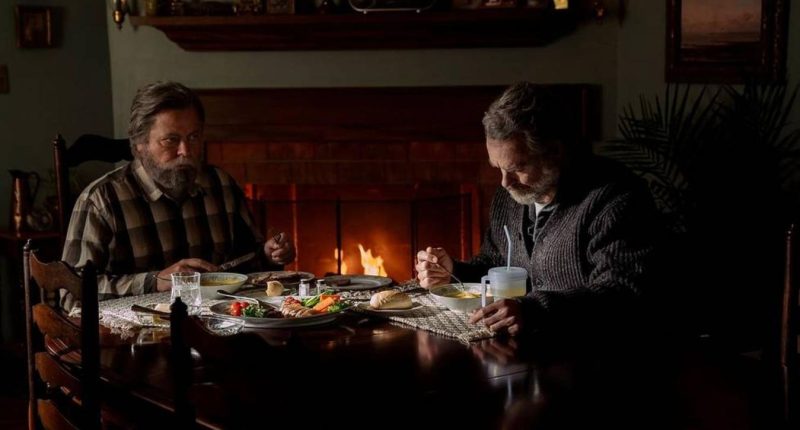Share this @internewscast.com
In The Last of Us, food isn’t just survival—it’s storytelling. Every skipped meal, every shared … More
Photograph by Liane Hentscher/HBO
With Season 2 of The Last of Us now streaming, we’re back in a world shaped by survival, scarcity, and the long tail of collapse. But even as the story moves forward, its origin still lingers—where a global pandemic begins with something as basic as flour.
It’s a small detail that changes everything. Because beneath the chaos and infected cityscapes, The Last of Us poses a quieter, more unnerving question: what happens when the foods we rely on most become the thing we fear?
When Routine Turns Against Us
A missed pancake breakfast. A forgotten birthday cake. In the show’s opening, it’s the absence of … More
Photograph by Liane Hentscher/HBO
Spoiler Alert: This article discusses major plot points from Seasons 1 and 2.
In the very first episode, there’s no dramatic outbreak. What saves Joel and Sarah isn’t brute strength or early warnings—it’s a series of missed meals. No pancake mix at breakfast. No birthday cake that night. No cookies from the neighbors. Each skipped food—flour-based and seemingly forgettable—is exactly what keeps them alive.
Later, we learn the truth: Cordyceps spores infiltrated the global food supply, with the infection spreading through mass-produced flour. It wasn’t the chaos of the streets or a bite from an infected—it was pancake mix. That detail reorients everything. The apocalypse doesn’t come roaring in with a bang. It starts at breakfast.
It’s a chilling reminder of how fragile our systems are. How quickly the most ordinary rituals can become dangerous. And how the foods that once brought us comfort can also carry hidden risk.
In real life, this tension isn’t far off. Recalls tied to flour, baking mixes, and cereal products have steadily risen over the past decade, from salmonella in pancake mix to E. coli in all-purpose flour. In 2023, the U.S. saw over 50 food recalls tied to potentially contaminated flour or processed grain products, according to FDA data. For many consumers, the memory of tossing out a bag of baking mix or questioning the safety of an ingredient is no longer hypothetical.
The bigger truth? Our emotional relationship to food doesn’t survive a crisis untouched. What we eat and how we feel about it shifts when safety feels compromised. And in moments of uncertainty, that shift doesn’t just happen on our plates—it happens in our sense of control.
A Missed Pancake, A Global Warning
Flour becomes the silent villain. As panic creeps in, the show reminds us: collapse doesn’t always … More
Getty Images
What makes The Last of Us so effective isn’t just the concept of collapse—it’s the slow, creeping loss of normalcy. A missed pancake doesn’t just represent a skipped breakfast. It becomes a metaphor for interrupted trust.
That’s what gives the show its emotional weight. It’s not just about monsters or mutations—it’s about memory, routine, and the eerie sense that something familiar has turned. The idea that the foods we share with others—the ones that build connection, tradition, and rhythm—might betray us is what makes this storyline hit harder than a typical apocalypse narrative.
And we’ve seen versions of that betrayal play out in real life. During the early months of the COVID-19 pandemic, shoppers weren’t just panic-buying—they were recalibrating trust. What was safe? What was available? What could be made at home, and what felt out of reach? In 2020, yeast sales surged over 600%, and flour flew off shelves for weeks at a time, per NIQ data. When food systems feel shaky, we start looking for a different kind of security—one we can make with our own hands.
Bill and Frank’s Bread: A Return to Care
In a world of scarcity, Bill and Frank choose intention. Homemade bread becomes more than … More
Photograph by Liane Hentscher/HBO
Partway through Season 1, The Last of Us takes a breath. Instead of chaos, we get quiet. Instead of fear, we get food.
In what became one of the series’ most celebrated episodes, we meet Bill and Frank—two men building a life, not just surviving one. They grow their own vegetables. They cook. They set a table. And they bake bread—made from scratch, safe because they know where it comes from. In a world where so much has broken, they bring intention back to the table.
That bread isn’t just a prop. It’s a signal. A symbol of ritual, of rebuilding, of returning to food with care. It marks a turning point—not just for the characters but for the show’s entire emotional arc. The story stops asking, “How do we survive?” and starts asking, “How do we live?”
Bread, in this context, becomes about more than nourishment. It becomes a form of agency.
And that shift mirrors real-life behavior in moments of collective upheaval. When trust in industrial food falters, we turn toward what we can control. We make. We grow. We source with intention. And even if we’re not baking our own bread from scratch, many of us still crave the feeling that we could.
The Foods We Choose, Even Now
After loss, after rupture, we return to what we can. Sometimes that means food. Sometimes that means … More
getty
The return of to bread in The Last of Us isn’t about nostalgia. It’s about adaptation.
The show doesn’t suggest we’ll ever go back to the way things were. It doesn’t promise safety or resolution. But it does show what it means to move forward—not through old systems, but through new understanding.
As Season 2 opens with the loss of Joel—a character shaped by grief, survival, and the routines that held him together—the show gets quieter but more personal. It’s not just about how the world ends. It’s about what we hang onto when the people, patterns, and meals we once trusted are gone. Food, like everything else, doesn’t always make it through. The real challenge isn’t just surviving—it’s figuring out how to rebuild trust from what’s left.
In the end, it’s not the big moments that break us. It’s the ones that used to feel ordinary. What we do with those—how we feed each other, even now—is where the story really begins again.




